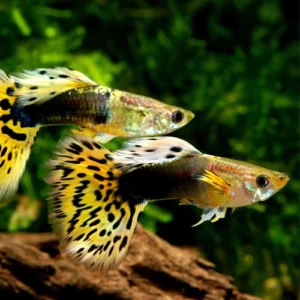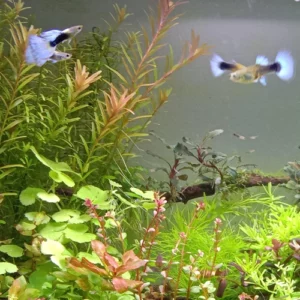Guppy Fin Rot: Causes, Symptoms, and Treatments
Fin rot is an aquatic ailment where guppies’ fins deteriorate because of bacterial or fungal invaders. Watch out for symptoms like frayed fins, color changes at fin edges, or decreased activity. When treating, employ medicated solutions, separate the affected guppies, fine-tune your water quality, and even explore nature’s remedies.
Home » Guides » Fish Care » Guppy » Guppy Fin Rot: Causes, Symptoms, and Treatments
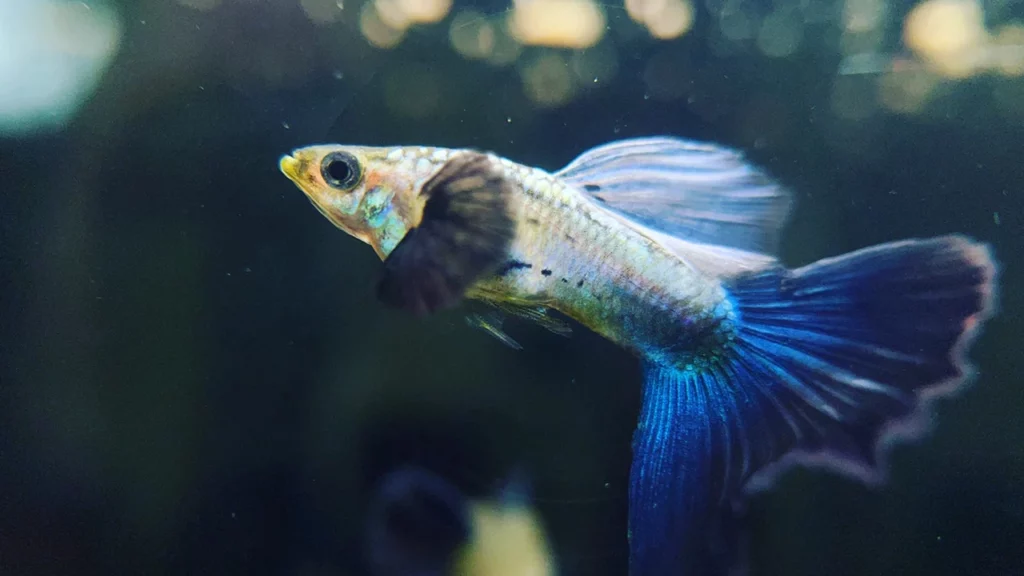
Guppy Fact Sheet
| Scientific Name | Poecilia Reticulata |
| Common Name | Guppy, Million Fish |
| Care Difficulty | Easy |
| Life Expectancy | 2+ Years |
| Average Size | 2 Inches (5cm) |
| Temperature | 72°F(22°C) – 82°F(28°C) |
| Diet | Omnivore |
| Behaviour | Friendly/Peaceful |
| Breeding | Easy |
| pH | 6.5-7.5 |
| Live Plant Friendly | Yes |
What is Fin Rot in Guppies?
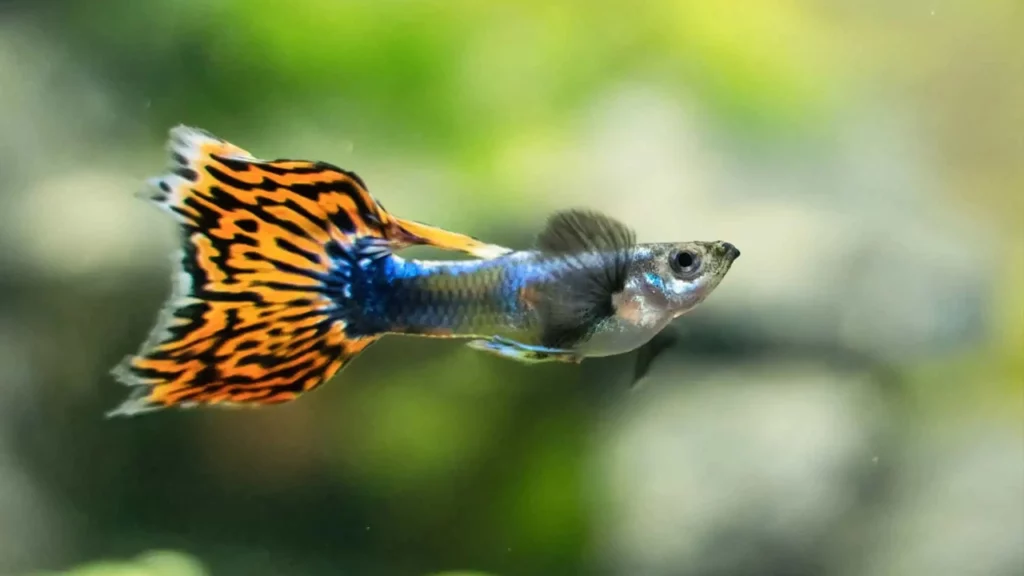
Basic Definition
It might sound like a pirate’s curse, but it’s actually a common disease that affects our finned friends. At a simple glance, fin rot is the gradual erosion or decay of a fish’s fins. When you see a fish with tattered or ragged fins, that’s a telltale sign. However, it’s not just an aesthetic concern; if left untreated, it can be lethal as the disease might progress to the body of the fish.
Think of it this way: Imagine wearing a beautiful, flowy dress or coat that slowly starts to fray at the edges. At first, it might just look a bit untidy, but soon, the fraying can go deeper, compromising the very fabric of the garment. In the same vein, a fish’s fins aren’t just for show; they’re vital for their mobility, balance, and overall well-being.
Now, you might be wondering, what causes such a distressing ailment in our aquatic companions? Well, hang tight! The reasons are manifold and we’ll be diving deep into those waters soon. For now, just remember that like all health issues in the living world, early detection and proper care can make all the difference.
Bacterial vs. Fungal Fin Rot
Differentiating between the two primary causes.
Now, when we talk about fin rot, there are mainly two villains at play: bacterial agents and fungal invaders. Both can be quite sneaky, but there are some subtle differences that will help us identify which one we’re dealing with.
- Bacterial Fin Rot: This is the more common of the two adversaries. Caused by gram-negative bacteria, this type of fin rot usually starts at the fin’s edges and works its way inward. The afflicted fin edges may appear milky or discolored, often with a reddish-brown or even black tint. The deterioration in this case is more progressive, often following a somewhat linear path of damage.
- Fungal Fin Rot: This mischief-maker is a bit rarer. When fungi are the culprits, you’ll notice the fins looking more like they’ve been munched on, with a rather uneven, ragged appearance. The affected areas might be bordered with a white, cottony edge, much like mold on bread. It’s nature’s way of telling you there’s a fungus among us!
Recognizing whether it’s bacteria or fungus causing the issue is pivotal, as the treatment varies. Think of it as distinguishing between a common cold and an allergy; while some symptoms might overlap, the root causes – and therefore, the remedies – are distinct.
Causes of Fin Rot in Guppies
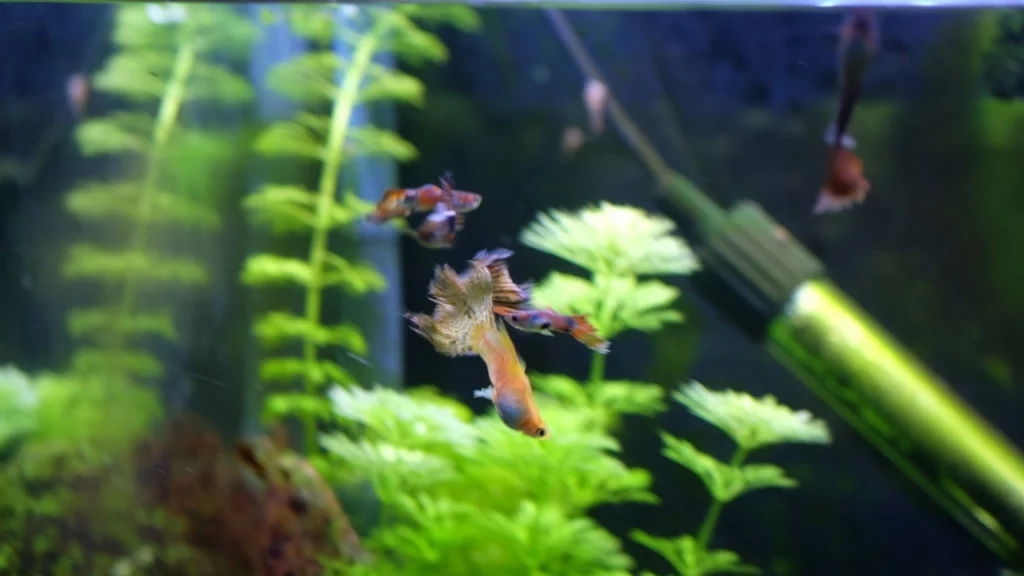
Poor Water Quality
Emphasizing the role of ammonia, nitrites, and stagnant water.
Ah, water. It’s the lifeblood of our fish, their very essence. But just as polluted air can affect our lungs, poor water quality can wreak havoc on our aquatic friends. When it comes to guppies and fin rot, it’s crucial to understand the role certain elements play:
- Ammonia: Often, in new aquariums, or ones where there’s an imbalance, ammonia levels can spike. This is particularly the case when there’s excessive fish waste, uneaten food, or dead plants. Ammonia is extremely toxic to fish, irritating their gills and making them more susceptible to diseases like fin rot.
- Nitrites: Even if ammonia is converted to nitrites by beneficial bacteria, we’re not out of the woods yet. Nitrites, albeit less toxic than ammonia, still pose a significant threat. Elevated nitrite levels can weaken our guppies’ immune systems, paving the way for opportunistic infections.
- Stagnant Water: An aquarium isn’t just a tank with water; it’s a dynamic ecosystem. Water needs to move, be oxygenated, and filtered. Stagnant water becomes a breeding ground for harmful bacteria and parasites. Moreover, it can create areas of low oxygen, stressing the fish.
The beauty of understanding these factors lies in the power it gives us. With regular testing and monitoring, we can ensure our guppies swim in pristine, health-promoting waters. After all, our aquarium is their sanctuary, and they depend on us to keep it in tip-top shape.
Physical Injury
How cuts or injuries can become infected.
Physical injuries, as much as they may sound like a brutish concept from an old gladiator movie, are a very real concern in the serene world of aquariums. Much like the human world, even a small injury can open doors to a plethora of complications if left unchecked.
- Cuts and Abrasions: Our guppies, despite their delicate appearance, are quite the adventurers. They love to explore every nook and cranny of their watery haven. But sometimes, sharp objects, rough decorations, or even abrasive substrates can lead to tiny cuts or scratches on their bodies or fins.
- Injury from Tankmates: Not all fish play nice. Some are territorial or just plain aggressive, nipping at the fins of other fish. Our guppies, with their beautiful, flowing tails, can sometimes become the target of such unwanted attention.
- Infection Gateway: Any injury, be it a minor scratch or a more pronounced tear, creates an open pathway for bacteria and fungi present in the water. Think of it like a tiny breach in a fortress’s wall, allowing invaders to storm in. Once these pathogens gain entry, they can cause infections, and in the context of our discussion, lead to fin rot.
- Weakened Immunity: Injuries, much like in us humans, can cause stress to fish. This stress can weaken their immune systems, making them even more susceptible to opportunistic infections. It’s a vicious cycle, really.
The moral of the story? Always ensure your aquarium decorations and substrates are safe, with no sharp edges. Keep a watchful eye on your guppies, especially when introducing new tankmates. An ounce of prevention, as they say, is worth a pound of cure.
Stressors
Role of factors like temperature fluctuations, bullying, or overcrowding.
When we think of stress, it’s easy to imagine a human bogged down by daily chores, work, and responsibilities. But did you know our aquatic buddies, too, face their own brand of stressors? Let’s unravel some of these:
- Temperature Fluctuations: Guppies are tropical fish, accustomed to a fairly consistent temperature range. Sudden changes, either spikes or drops, can be jarring. It’s akin to you suddenly walking from a cozy room into a snowstorm or a scorching desert. While guppies are resilient, repeated temperature shifts can wear them down, weakening their immune system and making them prone to ailments like fin rot.
- Bullying and Aggression: The fish world, for all its serenity, has its bullies. Larger fish, or even aggressive guppies, can harass their more peaceful tankmates. This constant pressure, fear of attack, or actual nipping and chasing can put immense stress on a guppy.
- Overcrowding: Picture this – you’re at a concert, shoulder to shoulder with strangers, with barely any room to breathe. That’s how guppies feel in an overcrowded tank. Overcrowding not only reduces the essential resources like food and hiding spots but also affects the water quality, leading to increased toxin levels.
- Inadequate Hiding Spots: Just like we enjoy a little me-time in the coziness of our homes, guppies too need their quiet corners. An environment devoid of plants, caves, or decorations deprives them of these much-needed respites, constantly exposing them to the open and potential threats.
Recognizing Symptoms of Fin Rot
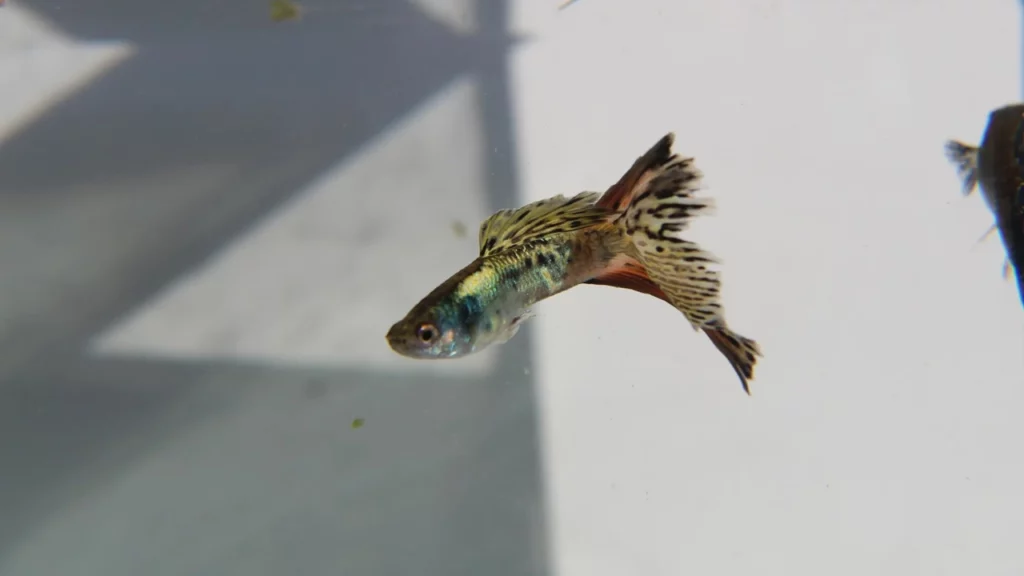
Fraying or Torn Fins
Initial signs of the disease
The majestic fins of a guppy, fluttering and swaying in the water, are their crowning glory. So, when these begin to fray or tear, it’s not just an aesthetic concern but a blaring siren of their health.
- The Frayed Look: The onset of fin rot often presents itself as subtle fraying at the edges of the fins. Picture a well-used fabric that’s starting to come apart at the seams. Instead of the even, flowing edges, you might notice the fins looking jagged or uneven.
- Torn Patches: As the condition progresses, these frays might become more pronounced, leading to evident tears or holes in the fins. It’s akin to holes appearing in an old, worn-out garment.
- Transparency or Thinning: Alongside the fraying, another sign to watch out for is a sudden transparency or thinning of the fins. Once robust and colorful fins might start appearing ghostly or faded.
- Swimming Difficulty: Fins, my friend, are not just for show. They play a pivotal role in a guppy’s mobility. As the fins deteriorate, you might notice your guppy struggling to swim or maintain balance. They might drift or sway more than usual.
Discoloration at Fin Edges
Recognizing unusual colors, such as black or red.
Imagine an artist’s palette. Now, while a splash of unexpected color can be a pleasant surprise on canvas, when it comes to our guppies’ fins, any deviation from the norm can be cause for concern.
- Dark Edges: One of the most telling signs of fin rot is the appearance of black or dark edges on the fins. It’s not the sort of artistic gradient we’d like. This typically signifies the tissue’s death and decay, a clear indicator that something is amiss.
- Red Streaks: Another sign to watch out for is the presence of reddish streaks or outlines on the fins. This doesn’t signify a change in fashion preference by our guppies. Instead, it’s often indicative of inflammation or blood vessel damage. It’s the fin’s way of raising a red flag, if you will.
- Fading Colors: In some cases, instead of a stark change, the fins might undergo a general fading or loss of vibrancy. Once bright and colorful fins might start to appear dull, losing their characteristic sheen.
- Change in Texture: Discoloration often comes hand in hand with a change in texture. The affected parts might seem thicker or even have a mucousy layer, quite different from the usual delicate and translucent fin tissue.
Reduced Mobility or Lethargy
Behavioral changes associated with advanced fin rot.
Fish, especially guppies with their playful nature, are often a spectacle of energy and zest. When this dynamic dance of life starts to wane, it’s a cue for us to sit up and take notice.
- Sluggish Movements: One of the most apparent signs of distress is a marked decrease in their usual lively movements. If your guppy, which once darted around with enthusiasm, now glides slowly or lingers at the bottom, it’s a sign they aren’t feeling their best.
- Resting More Than Usual: Every creature, aquatic or terrestrial, has its rhythm of activity and rest. But if you find your guppy resting more than usual, perhaps leaning against a plant, decoration, or just hovering listlessly near the substrate, it could be a symptom of advancing fin rot or associated discomfort.
- Difficulty in Swimming: Fins are not mere ornaments. They’re vital for navigation, balance, and propulsion. As fin rot progresses, the affected fins might hamper the guppy’s swimming ability, making them seem uncoordinated or causing them to swim in tilted or skewed patterns.
- Avoiding Currents: Guppies with compromised fins might find strong water currents challenging to handle. They might retreat to corners or behind decorations, seeking shelter from the flow, as they no longer possess the strength or agility to combat it.
Foul-smelling, Milky, or Slimy Film
Identifying more severe symptoms and potential secondary infections.
Our underwater friends live in a world of delicate balance. While water is their life source, any imbalance can turn it into a breeding ground for pathogens. Here’s what you need to be wary of:
- The Unpleasant Odor: The olfactory senses might not be the first tool we employ in fish care, but sometimes, it’s invaluable. A foul-smelling tank can indicate decaying organic matter, which includes deteriorating fish tissue from fin rot. If your tank starts giving off an unusual, unpleasant odor, it’s a signal something’s amiss.
- Milky Film: While the water in a healthy tank is crystal clear, like the pristine waters of a natural spring, a tank afflicted with advancing fin rot or secondary infections might develop a milky haze. This cloudy appearance can be due to a mix of decaying tissue, bacterial bloom, and other waste products.
- Slimy Layer on the Fish: In a bid to protect themselves from infections, guppies might produce excess mucus, resulting in a slimy, almost gelatinous coat. This is their body’s defense mechanism, akin to our immune response. But it’s also a clear SOS that they’re under duress.
- Deteriorating Health of Other Fish: Fin rot, especially in its advanced stages, can affect the overall aquatic environment. Other fish in the tank might show signs of distress or illness, a testament to the deteriorating water quality and the spread of infectious agents.
Treating Guppy Fin Rot
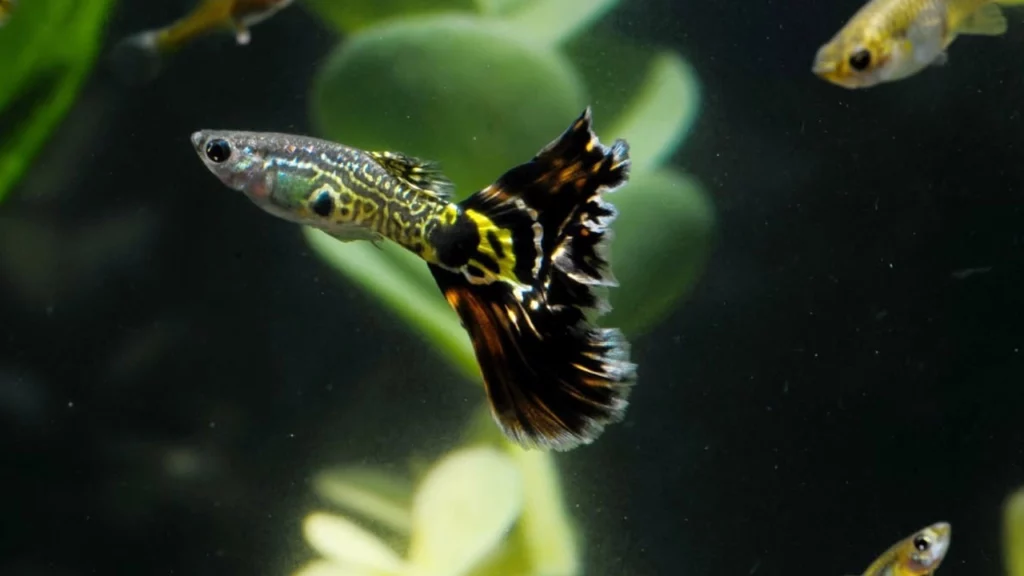
Medicated Treatments
Recommendations of antibiotics or antifungal medications.
Navigating the sea of medications can feel like mapping uncharted waters, but with a compass of understanding, we’ll find the right course.
- Antibiotics: If a bacterial cause is suspected for the fin rot (often the case), then antibiotics can be the weapon of choice. Common options include erythromycin, tetracycline, and kanamycin. But remember, antibiotics should be a targeted response. Overuse or misuse can lead to antibiotic-resistant bacteria, which are harder to combat.
- Antifungals: In cases where the fin rot has a fungal origin or if there’s a secondary fungal infection, antifungal treatments come into play. Medications like Pimafix and MelaFix can be considered. They not only combat the fungus but also promote healing of damaged fin tissue.
- Broad-spectrum treatments: Sometimes, identifying the exact culprit – be it bacterial or fungal – can be challenging. In such scenarios, broad-spectrum treatments, which act against a range of pathogens, can be helpful. An example is API Fungus Cure.
- Application Method: Medicated baths are a common method, where the guppy is immersed in a treatment solution for a set period. Alternatively, some treatments can be added directly to the quarantine tank.
- Dosage & Duration: It’s crucial to follow recommended dosages and treatment durations. Overdosing can be harmful, while underdosing might not be effective. Always consult the medication’s label or a trusted veterinarian for guidance.
- Observe & React: After administering the medication, keep a keen eye on your guppy. Look for signs of improvement, but also be alert for potential side effects. If you notice adverse reactions, it may be wise to halt the treatment and consult an expert.
Natural Remedies
Considering options like salt baths or herbal treatments.
In ancient times, before the age of modern medications, our ancestors often looked to nature for cures. The aquatic world is no different. Let’s unravel the mysteries of these age-old treatments:
- Salt Baths: As basic as it might sound, salt can be a powerful ally in treating fin rot. A carefully measured salt bath can help to draw out impurities, reduce swelling, and enhance the guppy’s natural healing processes. When I say salt, I’m referring to aquarium or kosher salt, not your everyday table salt. The absence of additives is key!
- Indian Almond Leaves (IAL): These leaves, when added to aquarium water, release tannins which possess antifungal and antibacterial properties. They mimic the guppy’s natural habitat and have a calming effect, reducing stress while promoting healing. The water might take on a tea-like color, but fear not, this is merely the therapeutic tannins at work.
- Garlic: Not just for repelling vampires, garlic has antiparasitic properties. Feeding guppies with garlic-infused food can help boost their immune system, making them more resilient against infections.
- Aloe Vera: A familiar remedy for sunburn in humans, aloe vera also has benefits for fish. When introduced into the tank, it can act as a natural stress reliever and help with tissue regeneration.
- Echinacea: This plant isn’t just beneficial for human colds. It can boost a guppy’s immune system when added to their diet, helping them to fend off infections naturally.
Improving Water Quality
Regular water changes and ensuring proper filtration.
You see, a guppy’s health often mirrors the quality of its aquatic home. If that home is pristine, the guppy thrives. If it’s compromised, so too is our guppy’s health. Let’s explore how to ensure this watery stage remains impeccable:
- Regular Water Changes: Think of this as refreshing the air in a room. By changing 25-30% of the tank water weekly, we’re not just removing potential contaminants, but we’re also replenishing essential minerals that our guppies need. Remember to use dechlorinated water, ensuring it’s at a similar temperature to the tank to prevent shocking our finned friends.
- Efficient Filtration: A good filter doesn’t just remove physical debris. It also helps in breaking down harmful chemicals, thanks to the beneficial bacteria residing in it. Ensure that the filter is appropriate for the tank size and is regularly cleaned – but be gentle with those beneficial bacteria!
- Test the Waters: Regularly test the water for ammonia, nitrites, and nitrates. These parameters are like the heartbeat, blood pressure, and temperature of the tank. Keeping them in check is vital. Aim for 0 ppm ammonia and nitrite, with nitrates ideally below 20 ppm.
- Avoid Overfeeding: Leftover food decays, leading to ammonia spikes. Feed your guppies an amount they can consume in 2-3 minutes and monitor for residues.
- Live Plants: Introducing live plants can further enhance water quality. They absorb some of the waste products and provide refuge, mimicking a guppy’s natural environment.
- Aerate: Ensuring proper oxygenation with air stones or bubblers keeps the water fresh and supports the overall well-being of the aquatic community.
Preventing Future Outbreaks
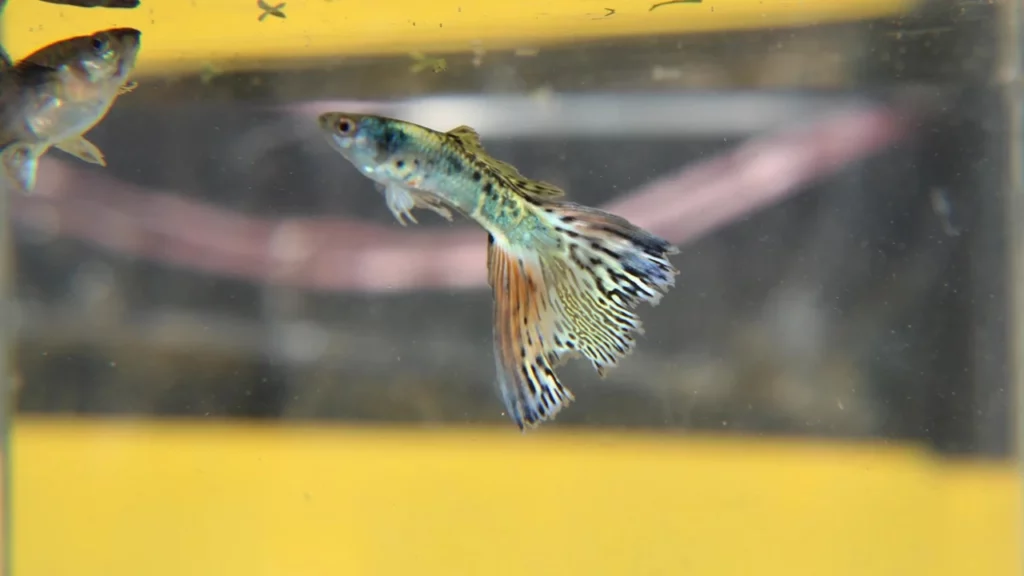
Regular Water Testing
Maintaining optimal parameters to keep guppies healthy.
In the aquatic world, things can change beneath the surface without any visible signs above. Regular water testing is akin to taking the pulse of our guppy’s environment.
- Importance of Regular Testing: Just as a doctor wouldn’t guess your health without tests, we shouldn’t assume our tank’s health. By regularly testing the water parameters, we can detect potential problems before they become visible crises.
- Key Parameters:
- Ammonia: The waste produced by fish and decomposing matter turns into ammonia. It’s like the CO2 we exhale but for fish. Too much, and it becomes toxic. Aim for 0 ppm.
- Nitrite: It’s the ‘middle stage’ in the breakdown of waste. Still toxic, and again, the aim is 0 ppm.
- Nitrate: The final product of the cycle. Less toxic than its predecessors, but in high concentrations, it can stress our guppies. Aim to keep it below 20 ppm.
- pH Level: Guppies generally thrive in a pH range of 6.8 to 7.8. Deviations can stress them, so it’s essential to monitor and maintain this balance.
- Testing Frequency: For a well-established tank, testing once every week or two should suffice. However, if there’s a change, like adding new fish or plants, test more frequently.
- Act on Results: Testing alone isn’t enough. If discrepancies arise, act on them. Adjustments might involve water changes, adjusting the tank’s cycle, or even changing food or decor that might be affecting the water chemistry.
- Document Changes: Keeping a logbook of your water parameters over time can be insightful. Spotting trends becomes easier, and you can preemptively adjust to avoid potential problems.
Proper Diet and Nutrition
Ensuring guppies have a strong immune system.
As with humans, the adage “You are what you eat” holds profound truth for our guppies. Their vitality, coloration, and resistance to illnesses are intrinsically linked to their diet.
- Varied Diet: Guppies are omnivores by nature. In the wild, their menu includes algae, small invertebrates, and plant matter. To mimic this, provide a mix of high-quality flake food, live or frozen brine shrimp, daphnia, and occasional vegetable bits like zucchini or lettuce.
- Quality Over Quantity: Opt for reputable fish food brands. They ensure the right balance of proteins, fats, and essential vitamins. A well-fed guppy not only flaunts vibrant colors but also boasts a robust immune system.
- Avoid Overfeeding: One of the most common mistakes in the aquarium hobby! Feed small amounts that can be consumed within 2-3 minutes. Excess food leads to tank pollution, which can stress and sicken our guppies.
- Observe and Adjust: Every guppy is unique. Observing their feeding habits and adjusting quantities or types of food can lead to better health and fewer leftovers.
- Vitamin Supplements: Occasionally, adding liquid vitamins to their food can give them that extra boost, especially during periods of stress or after illness.
- Natural Probiotics: Did you know? Certain foods, like fermented green peas, act as natural probiotics, promoting gut health and aiding in digestion.
Frequently Asked Questions – FAQ
Give Us Feedback
Please help us get better by making suggestions or giving feedback, we really do listen to it!
